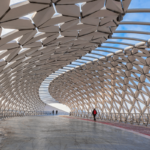Best Places to Visit in East Asia

Introduction
East Asia is a captivating region where ancient traditions harmoniously blend with cutting-edge modernity. This region, encompassing countries like China, Japan, South Korea, Taiwan, and Mongolia, offers a wealth of diverse experiences. From bustling metropolises to serene landscapes, East Asia is a treasure trove of cultural, historical, and natural wonders. This article explores some of the best places to visit in East Asia, highlighting their unique attractions and experiences.
China
1. Beijing
- The Great Wall: One of the world’s most iconic landmarks, the Great Wall stretches across northern China, with well-preserved sections like Badaling and Mutianyu near Beijing.
- The Forbidden City: This vast imperial palace complex offers a glimpse into China’s royal past and is a UNESCO World Heritage site.
- Temple of Heaven: A beautiful complex of religious buildings where emperors prayed for good harvests.
2. Shanghai
- The Bund: A waterfront area with colonial-era buildings and a stunning view of the modern Pudong skyline.
- Shanghai Tower: The second tallest building in the world, offering breathtaking views from its observation deck.
- Yu Garden: A classical Chinese garden with beautiful pavilions, ponds, and rockeries.
3. Xi’an
- Terracotta Army: Thousands of life-sized clay soldiers and horses buried with China’s first emperor, Qin Shi Huang.
- Ancient City Wall: One of the best-preserved city walls in China, offering great views of the city.
- Big Wild Goose Pagoda: A historic Buddhist pagoda built in the Tang Dynasty.
Japan
1. Tokyo
- Shibuya Crossing: Known as the world’s busiest pedestrian crossing, it’s a symbol of Tokyo’s vibrant energy.
- Tokyo Tower: A communications and observation tower inspired by the Eiffel Tower, offering panoramic views of the city.
- Senso-ji Temple: Tokyo’s oldest temple, located in the historic Asakusa district.
2. Kyoto
- Fushimi Inari Shrine: Famous for its thousands of red torii gates leading to the sacred Mount Inari.
- Kinkaku-ji (Golden Pavilion): A stunning Zen Buddhist temple covered in gold leaf.
- Arashiyama Bamboo Grove: A picturesque bamboo forest that provides a serene escape from the city.
3. Osaka
- Osaka Castle: A historic landmark surrounded by beautiful gardens and moats.
- Dotonbori: A lively entertainment district known for its neon lights, street food, and shopping.
- Universal Studios Japan: A popular theme park with attractions based on movies and TV shows.

South Korea
1. Seoul
- Gyeongbokgung Palace: The largest of Seoul’s five grand palaces, offering a glimpse into Korea’s royal history.
- N Seoul Tower: A landmark offering panoramic views of the city from its observation deck.
- Myeongdong: A bustling shopping district known for its fashion boutiques, cosmetics shops, and street food.
2. Busan
- Haeundae Beach: One of Korea’s most famous beaches, perfect for swimming, sunbathing, and festivals.
- Gamcheon Culture Village: A colorful hillside community with murals, sculptures, and narrow alleys.
- Jagalchi Fish Market: The largest seafood market in Korea, offering fresh catches and local delicacies.
3. Jeju Island
- Seongsan Ilchulbong (Sunrise Peak): A UNESCO World Heritage site and volcanic crater offering stunning sunrise views.
- Manjanggul Cave: One of the longest lava tubes in the world, featuring impressive rock formations.
- Jeju Olle Trail: A network of scenic walking paths around the island’s coastline, forests, and mountains.
Taiwan
1. Taipei
- Taipei 101: Once the world’s tallest building, it offers breathtaking views and features a high-end shopping mall.
- National Palace Museum: Home to one of the world’s largest collections of Chinese art and artifacts.
- Shilin Night Market: A bustling market famous for its street food, games, and shopping.
2. Taroko Gorge
- Taroko National Park: Known for its stunning marble cliffs, deep gorges, and scenic trails.
- Swallow Grotto: A narrow section of the gorge with tunnels and breathtaking views of the Liwu River.
- Eternal Spring Shrine: A picturesque shrine built to honor workers who died during the construction of the Central Cross-Island Highway.

3. Kaohsiung
- Liuhe Night Market: A vibrant market known for its seafood, snacks, and local specialties.
- Lotus Pond: A scenic area with numerous temples, pagodas, and the famous Dragon and Tiger Pagodas.
- Fo Guang Shan Buddha Museum: A large Buddhist complex with a massive Buddha statue and cultural exhibits.
Mongolia
1. Ulaanbaatar
- Gandan Monastery: The largest and most important Buddhist monastery in Mongolia.
- Chinggis Khan Statue Complex: A massive statue of Genghis Khan on horseback, offering panoramic views of the surrounding area.
- National Museum of Mongolia: Exhibits on Mongolia’s history, from prehistoric times to the present.
2. Gobi Desert
- Khongoryn Els: Known as the “Singing Sand Dunes,” these massive dunes are famous for the sound they produce when the sand shifts.
- Yolyn Am: A deep and narrow gorge in the Gurvan Saikhan Mountains, known for its stunning scenery and ice fields.
- Bayanzag (Flaming Cliffs): Famous for its red sandstone cliffs and significant dinosaur fossil discoveries.
3. Khuvsgul Lake
- Description: Often referred to as the “Blue Pearl of Mongolia,” this pristine lake is surrounded by mountains and lush forests.
- Highlights: Activities include hiking, horseback riding, and exploring the traditional nomadic culture of the Tsaatan people.






